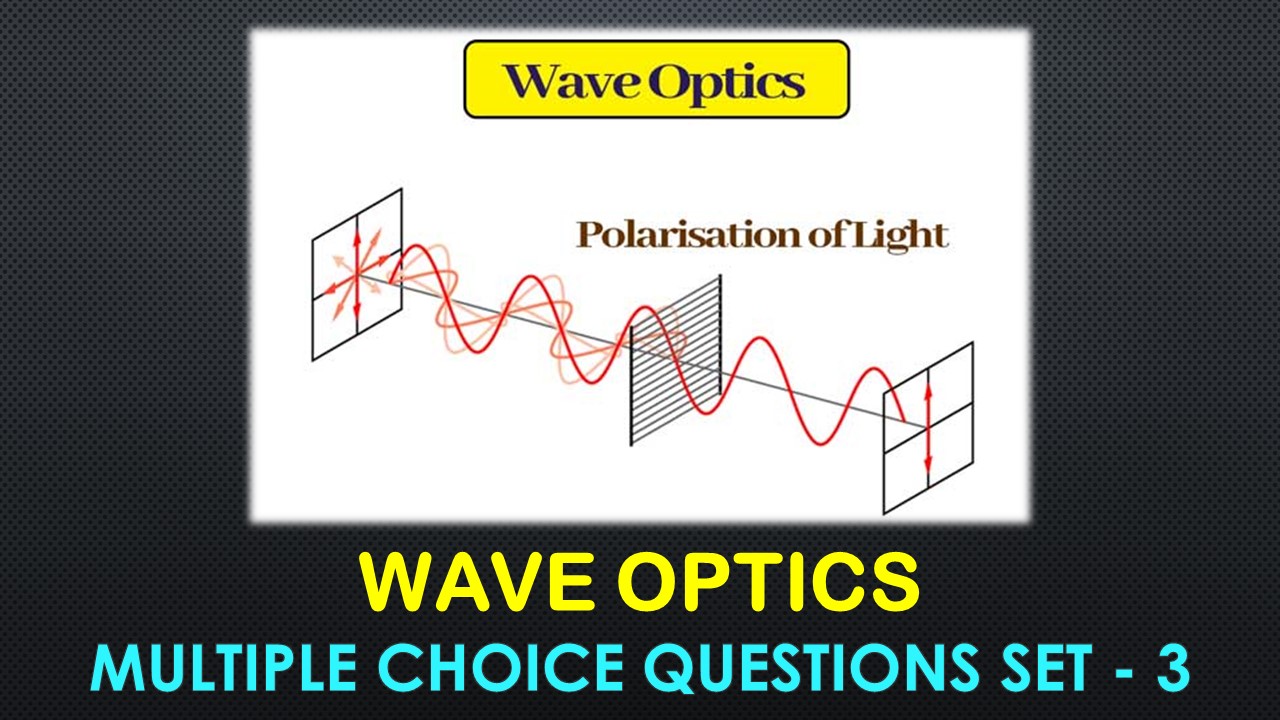CBSE Class 12 Wave Optics Multiple Choice Questions with Answers. MCQ Questions Class 12 Wave Optics with Answers Is Prepared Based on Latest Exam Pattern. Students can solve NCERT Class 12 Wave Optics MCQs with Answers to know their preparation level.
Students who are searching for NCERT MCQ Questions for Class 12 Wave Optics with Answers are compiled here to get good practice on all fundamentals. Know your preparation level on MCQ Questions for Class 12 Wave Optics with Answers. You can also verify your answers from our provided MCQ Class 12 Wave Optics with Answers. So, ace up your preparation with MCQ of Class 12 Physics Examinations.
MCQ Questions Class 12 Wave Optics with Answers - Set - 3
Question 1:
Two sources of light are said to be coherent when both give out light waves of the same:
(a) amplitude and phase
(b) intensity and wavelength
(c) speed
(d) wavelength and a constant phase difference
Correct Answer – (D)
Question 2 :
When a polaroid is rotated, the intensity of light does not vary. The incident light may be:
(a) unpolarised
(b) completely polarised
(c) partially plane polarised
(d) None of the above
Correct Answer – (A)
Question 3 :
A single slit diffraction pattern is obtained using a beam of red light What happened the red light is replaced by the blue light?
(a) There is no change in diffraction pattern
(b) Diffraction fringes become narrower and crowded
(d) Diffraction fringes become broader and farther apart
(d) The diffraction pattern disappear
Correct Answer – (B)
Question 4 :
What happens to the interference pattern the two slits S1 and S2 in Young’s double experiment are illuminated by two independent but identical sources?
(a) The intensity of the bright fringes doubled
(b) The intensity of the bright fringes becomes four times
(c) Two sets of interference fringes overlap
(d) No interference pattern is observed
Correct Answer – (D)
Question 5 :
Two waves of the same frequency and same intensity are super impossed in the same phase. The intensity of the resultant wave at the Central point will be
(a) equal to that of the individual wave.
(b) 3 times that of individual wave.
(c) 2 times that of individual wave.
(d) 4 times that of individual wave.
Correct Answer – (D)
MCQ Questions Class 12 Wave Optics with Answers
Question 6 :
For sustained interference, we need two sources which
emit radiations :
(a) of the same intensity
(b) of the same amplitude
(c) having a constant phase difference
(d) None of these
Correct Answer – (C)
Question 7 :
When a polaroid is rotated, the intensity of light varies but never reduces to zero. It shows that the incident light is:
(a) unpolarised
(b) completely plane polarised
(c) partially plane polarised
(d) None of the above
Correct Answer – (C)
Question 8 :
What is the reason for your answer to the above question?
(a) The two sources do not emit light of the same wavelength
(b) The two sources emit waves which travel with different speeds
(c) The two sources emit light waves of different amplitudes
(d) There is not constant phase difference between the waves emitted by the two sources
Correct Answer – (D)
Question 9 :
What happens if one of the slits, say S1 in Young’s double , slit experiment-is covered with a glass plate which absorbs half the intensity of light from it?
(a) The bright fringes become less-bright and the dark fringes have a finite light intensity
(b) The bright fringes become brighter and the dark fringes become darker
(c) The fringe width decreases
(d) No fringes will be observed
Correct Answer – (A)
Question 10 :
One important similarity between sound and light waves is that both:
(a) can pass through even in the absence of any medium.
(b) can show interference effects.
(c) are transverse waves.
(d) travel at the same speed in air.
Correct Answer – (B)
- NCERT Solutions Class 11 Chemistry Chapter 1 : Some Basic Concepts of Chemistry
- NCERT Solutions Class 11 Chemistry Chapter 2 : Structure Of The Atom
- NCERT Solutions Class 11 Chemistry Chapter 3 : Classification of Elements and Periodicity in Properties
- NCERT Solutions Class 11 Chemistry Chapter 4 : Chemical Bonding and Molecular Structure
- NCERT Solutions Class 11 Chemistry Chapter 5 : States of Matter
- NCERT Solutions Class 11 Chemistry Chapter 6 : Thermodynamics
- NCERT Solutions Class 11 Chemistry Chapter 7 : Equilibrium
- NCERT Solutions Class 11 Chemistry Chapter 8 : Redox Reactions
- NCERT Solutions Class 11 Chemistry Chapter 9 : Hydrogen
- NCERT Solutions Class 11 Chemistry Chapter 10 : The s-Block Elements
- NCERT Solutions Class 11 Chemistry Chapter 11 : The p-Block Elements
- NCERT Solutions Class 11 Chemistry Chapter 12 : Organic Chemistry: Some Basic Principles and Techniques
- NCERT Solutions Class 11 Chemistry Chapter 13 : Hydrocarbons
- NCERT Solutions Class 11 Chemistry Chapter 14 : Environmental Chemistry




